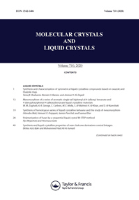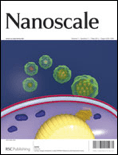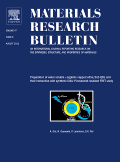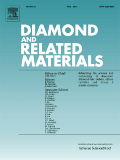
JOURNAL OF MATERIALS SCIENCE-MATERIALS IN ELECTRONICS
Scope & Guideline
Advancing the Frontiers of Materials in Electronics
Introduction
Aims and Scopes
- Materials Synthesis and Characterization:
The journal publishes studies on various synthesis techniques including hydrothermal, sol-gel, and chemical vapor deposition, alongside detailed characterization methods such as X-ray diffraction, scanning electron microscopy, and thermal analysis. - Nanomaterials and Nanocomposites:
Research on nanomaterials, including their properties and applications in electronics, is a core focus area. This includes the synthesis of nanocomposites and their potential applications in sensors, batteries, and photovoltaic devices. - Optoelectronic and Photonic Applications:
The journal encourages submissions that explore the use of materials in optoelectronic devices such as solar cells, LEDs, and sensors, highlighting advancements in performance and efficiency through novel material compositions. - Functional Materials for Energy Applications:
Research related to materials for energy storage and conversion, such as supercapacitors and batteries, is prominently featured, addressing the urgent need for sustainable energy solutions. - Magnetic and Dielectric Materials:
The journal also covers studies on magnetic and dielectric materials, focusing on their applications in high-frequency electronics, sensors, and microwave devices. - Environmental Applications of Materials:
Papers exploring the photocatalytic degradation of pollutants, gas sensing, and other environmental applications of materials are included, reflecting the journal's commitment to sustainability.
Trending and Emerging
- Perovskite Materials for Photovoltaics:
The rise of perovskite materials in solar cell research has been significant, with numerous studies focusing on improving their stability and efficiency, indicating a shift towards more sustainable and high-performance energy solutions. - 2D Materials and Heterostructures:
Research on two-dimensional materials, such as graphene and transition metal dichalcogenides, is trending, especially regarding their applications in flexible electronics and photodetectors. - Biomass-Derived Materials:
An emerging trend is the use of biomass and green synthesis methods for producing carbon-based materials and composites, reflecting a broader interest in sustainability and eco-friendly practices in materials development. - Flexible and Wearable Electronics:
There is an increasing focus on the development of flexible and wearable electronic devices, with studies exploring novel materials and designs that can withstand mechanical stress while maintaining performance. - Multifunctional Materials:
Research is increasingly centered on multifunctional materials that can serve dual or multiple purposes, such as energy storage and sensing, indicating a trend towards integrated solutions in electronic applications. - Advanced Characterization Techniques:
The use of advanced characterization techniques, including machine learning approaches for materials discovery and optimization, is becoming more prevalent, demonstrating the integration of computational methods with experimental research.
Declining or Waning
- Traditional Semiconductor Materials:
There has been a noticeable decline in research focused solely on traditional semiconductor materials such as silicon, as the field shifts towards novel materials like perovskites and 2D materials that offer enhanced properties for electronic applications. - Conventional Energy Harvesting Techniques:
Research on conventional energy harvesting materials and techniques, such as thermoelectric materials, has decreased as interest grows in integrating multifunctional materials that can serve multiple applications simultaneously. - Static Dielectric Materials:
The focus on static dielectric materials and their applications in traditional capacitor designs is waning, with more emphasis being placed on dynamic materials that can adapt to varying conditions and requirements. - Bulk Material Studies:
Research centered around bulk materials without consideration for nanoscale properties has diminished, reflecting a growing recognition of the importance of nanoscale phenomena in material performance.
Similar Journals

Nanomaterials, published by MDPI in Switzerland, stands as a leading platform in the realm of materials science and chemical engineering. Since its inception in 2011, this Open Access journal has garnered significant attention, reflected in its impressive rankings—placing in the Q1 category for Chemical Engineering and Q2 for Materials Science as per the 2023 quartiles. The journal consistently fosters innovation and interdisciplinary research through its rigorous peer-reviewed articles, inviting submissions that span a wide range of topics from nanostructured materials to advanced engineering techniques. With a commendable Scopus rank—#44 in Chemical Engineering and #93 in Materials Science, both within the top percentiles—Nanomaterials serves as an essential resource for researchers, professionals, and students eager to stay abreast of developments in this rapidly evolving field. Since its establishment, it has distinctively contributed to the academic community by facilitating insightful knowledge exchange and promoting high-quality research around nanoscale materials.

MOLECULAR CRYSTALS AND LIQUID CRYSTALS
Advancing Knowledge in Crystalline FrontiersMOLECULAR CRYSTALS AND LIQUID CRYSTALS is a distinguished journal published by Taylor & Francis Ltd, dedicated to the comprehensive examination of the structural and physical properties of molecular crystals and liquid crystals, with applications spanning fields such as chemistry, materials science, and condensed matter physics. Established in 1972, this journal has carved out a niche in the academic landscape despite facing recent challenges, as reflected in its current quartile rankings of Q4 across multiple categories in 2023. The journal not only serves as a platform for groundbreaking research but also invites contributions that further explore the intricate relationships between molecular organization and material properties, thereby advancing our understanding of these fascinating substances. With a commitment to fostering scientific dialogue, MOLECULAR CRYSTALS AND LIQUID CRYSTALS aims to reach a broad audience of researchers, professionals, and students, providing insights that are pivotal in driving innovation in materials research.

MRS Advances
Where Cutting-edge Research Meets Practical ApplicationsMRS Advances, published by Springer Heidelberg, is an esteemed academic journal that serves as a vital platform for disseminating cutting-edge research in the fields of condensed matter physics, materials science, and mechanical engineering. With an ISSN of 2731-5894 and an E-ISSN of 2059-8521, the journal is hosted in Switzerland and encompasses an impressive spectrum of innovative studies that impact both theoretical and practical applications. Throughout its converged years from 2012 and continuing through 2024, MRS Advances has established itself with notable rankings, including Q4 in condensed matter physics and Q3 in several related categories. This journal not only enriches the academic community with its rigorous peer-reviewed articles, but also encourages open discussions that further advance research innovations. Although currently not designated as an open-access journal, its accessibility through institutional subscriptions ensures that professionals, researchers, and students can engage with the latest advancements in the material science arena. Emphasizing its relevance, MRS Advances is dedicated to fostering interdisciplinary collaboration and inspiring new discoveries within the global research community.

Nanoscale
Connecting Global Minds in Nanoscience.Nanoscale is a premier academic journal published by the Royal Society of Chemistry, dedicated to advancing the field of nanoscience and nanotechnology. With both its ISSN (2040-3364) and E-ISSN (2040-3372) ensuring wide accessibility, the journal is renowned for its high-impact research contributions, reflected in its impressive 2023 Impact Factor and prestigious Q1 ranking in both Materials Science (Miscellaneous) and Nanoscience and Nanotechnology categories. Since its inception in 2009, Nanoscale has fostered a collaborative platform where leading researchers from around the globe share their innovative findings across a multitude of topics spanning from material synthesis to applications in nanotechnology. The journal not only serves as a valuable resource for professionals, researchers, and students but also actively engages the academic community in discussing emerging trends, thus shaping the future of nanoscience. Situated in the heart of the UK at Thomas Graham House, Science Park, Milton Rd, Cambridge CB4 0WF, Nanoscale remains a key publication for those looking to keep abreast of the latest breakthroughs in an ever-evolving field.

Advanced Electronic Materials
Pioneering Breakthroughs in Electronic ScienceAdvanced Electronic Materials is an esteemed journal published by Wiley, dedicated to the forefront of materials science, particularly in the areas of electronic, optical, and magnetic materials. With a commendable impact factor that places it in the Q1 quartile of its category and a Scopus rank of 36 out of 284, the journal is a vital resource for researchers, professionals, and students aiming to contribute to this rapidly evolving field. Launched in 2015 and fully transitioned to Open Access in 2023, the journal promotes widespread dissemination of knowledge, ensuring accessibility to groundbreaking research findings. With its address located in Germany at 111 River St, Hoboken 07030-5774, NJ, it serves a global academic community eager to explore innovative materials technologies that influence diverse applications ranging from consumer electronics to advanced manufacturing. As researchers seek to push the boundaries of what is possible with materials, Advanced Electronic Materials stands as a premier platform for sharing, discovering, and advancing knowledge in this essential domain.

JOURNAL OF MATERIALS SCIENCE
Elevating Understanding in Materials ScienceJOURNAL OF MATERIALS SCIENCE, published by SPRINGER, stands as a highly regarded periodical in the field of materials science, delivering impactful research since its inception in 1966. With an impressive Q1 ranking in both Mechanical Engineering and Mechanics of Materials, alongside strong Q2 positions in Ceramics, Composites, and General Materials Science, this journal serves as a pivotal resource for scholars and practitioners alike. It offers insightful contributions that span a diverse range of topics, from emerging materials to advanced applications in engineering. With a robust Scopus ranking reflecting its global influence—ranking 91 out of 672 in Mechanical Engineering and 63 out of 398 in Mechanics of Materials—the JOURNAL OF MATERIALS SCIENCE maintains an essential role in advancing the understanding and innovation within the discipline. Researchers, professionals, and students are encouraged to access this esteemed journal to keep abreast of groundbreaking findings and methodologies that shape the future of materials science.

MATERIALS RESEARCH BULLETIN
Advancing materials science for a sustainable future.MATERIALS RESEARCH BULLETIN is a prestigious journal published by Pergamon-Elsevier Science Ltd, dedicated to advancing the field of materials science and engineering. Since its inception in 1966, the journal has served as a platform for high-impact research, particularly in areas such as condensed matter physics, mechanical engineering, and materials mechanics. With an impressive Q1 ranking in multiple categories, including Condensed Matter Physics and Materials Science, MATERIALS RESEARCH BULLETIN stands out as a leading resource in its domain, aiming to disseminate innovative research findings and methodologies that address fundamental and applied aspects of materials. The journal’s rigorous peer-review process ensures the publication of high-quality articles, making it an essential resource for researchers, professionals, and students alike. With its ongoing commitment to fostering scientific discourse and collaboration, MATERIALS RESEARCH BULLETIN remains at the forefront of materials research, contributing significantly to the global scientific community.

DIAMOND AND RELATED MATERIALS
Elevating the discourse on cutting-edge materials.DIAMOND AND RELATED MATERIALS, published by Elsevier Science SA, serves as a premier international platform for the dissemination of high-quality research in the fields of materials science, electrical engineering, and chemistry, with a specialized focus on diamond and its related materials. With an ISSN of 0925-9635 and an E-ISSN of 1879-0062, this journal has established itself within the top quartiles, reflecting its influential contribution to the scientific community, particularly in the categories of Chemistry (miscellaneous) and Electrical Engineering, among others. The journal's wide scope encompasses both theoretical and applied aspects of diamond research, making it an essential resource for professionals and academics alike. The current rankings position it favorably within its respective disciplines, with a notable 79th percentile in General Physics and Astronomy and strong standings in related categories. Although it does not offer open access, researchers can stay informed of cutting-edge advancements and methodologies through its comprehensive articles and reviews, enriching the wider discourse in advanced materials research.

ADVANCED FUNCTIONAL MATERIALS
Pioneering Innovations in Functional MaterialsADVANCED FUNCTIONAL MATERIALS is a leading journal published by WILEY-V C H VERLAG GMBH, prominently recognized in the fields of biomaterials, chemistry, condensed matter physics, and materials science. With an impressive impact factor and a distinguished position in the Q1 quartile across multiple categories including nanoscience and nanotechnology, this journal serves as a vital platform for researchers and professionals committed to innovating in functional materials. Since its inception in 2000, ADVANCED FUNCTIONAL MATERIALS has published high-quality peer-reviewed articles that push the boundaries of materials science, exploring new frontiers in electronic, optical, and magnetic materials. The journal's dedication to open access ensures that its groundbreaking findings are readily available to a global audience, fostering collaboration and knowledge-sharing among scholars and practitioners in the field. For those seeking to stay at the forefront of materials research, ADVANCED FUNCTIONAL MATERIALS is an essential resource.

ECS Journal of Solid State Science and Technology
Unlocking the Potential of Solid State InnovationsECS Journal of Solid State Science and Technology, published by the Electrochemical Society, is a prominent journal dedicated to the advancement of research in the field of electronic, optical, and magnetic materials. With an ISSN of 2162-8769 and an E-ISSN of 2162-8777, this journal has established a significant presence since its inception in 2012, spanning critical developments in solid-state science that are essential for innovative technologies. Operating within the United States and recognized for its global outreach, it holds a respectable Q3 category ranking in the materials science category as of 2023, reflecting its commitment to high-quality research and its role in bridging theoretical and applied aspects of materials science. Researchers, professionals, and students alike will find vital information and cutting-edge studies that further the understanding and applications of solid-state technologies. The journal is accessible to an extensive audience, making it an invaluable resource for those engaged in the ever-evolving landscape of materials science.